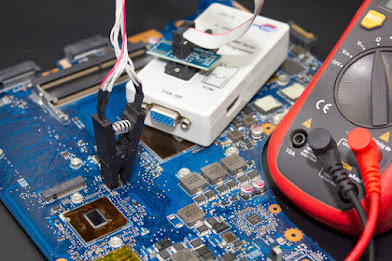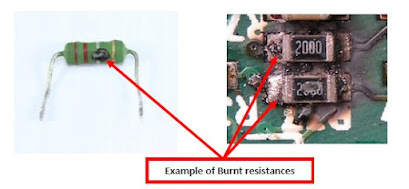Laptop Not Turning On – (Power Issue)
Few things are more frustrating than pressing the power button on your laptop and… nothing happens. No lights, no sound, no screen — just silence. If your laptop won’t turn on, appears completely dead, or shows no sign of power, don’t panic. This issue is common and often fixable with some systematic troubleshooting.
In this detailed guide, we’ll explore:
- The most common symptoms of a dead laptop
- Possible causes of power not working
- Step-by-step fixes you can try at home
- When to suspect a motherboard failure
- How technicians solve deeper power IC problems
Why Won’t My Laptop Turn On?
There are multiple reasons why your laptop may not respond when you press the power button. The issue could be as simple as a faulty charger, or as complex as a burned-out power IC on the motherboard. By understanding the signs and causes, you can narrow down the problem and find the right solution.
Keywords to Keep in Mind
If you’re searching online for help, terms like laptop won’t turn on, laptop dead, power not working are among the most common. This means you’re not alone — thousands of users face this issue every day.
Common Symptoms of Laptop Dead Power Issue
Before attempting fixes, identify the specific symptom your laptop shows. This helps in diagnosing the problem accurately.
- No lights or sound: When pressing the power button, nothing happens. No LED indicator, no fan noise, no screen flicker.
- Won’t boot with charger or battery: Even when plugged in or using battery alone, the laptop remains unresponsive.
- Charging light off: The charging LED doesn’t turn on when the adapter is connected.
- Intermittent response: Sometimes the laptop powers on briefly, then shuts down again.
Possible Causes of Laptop Not Powering On
1. Charger or Power Adapter Fault
The adapter may be defective, underpowered, or not delivering electricity to the laptop. Using the wrong wattage charger can also cause this issue.
2. Battery Issues
A dead or faulty battery can prevent the laptop from starting, especially if the laptop requires battery presence even when on AC power.
3. Loose or Damaged Power Jack
The DC jack (where you plug the charger) may be loose, broken, or disconnected internally from the motherboard.
4. CMOS or BIOS Error
Corrupted BIOS settings or a shorted CMOS battery may block startup.
5. Motherboard or Power IC Failure
The most serious cause is a failure of components on the motherboard, such as the power IC, MOSFETs, or capacitors.
Step-by-Step Fixes for Laptop Power Issues
Here are tested troubleshooting steps that often resolve the problem:
1. Test the Charger
- Use a multimeter to check if the charger outputs the correct voltage.
- Borrow another compatible charger and see if the laptop turns on.
2. Check the Battery
- Remove the battery (if removable) and try powering on with only the charger.
- If the laptop works without the battery, replace the faulty battery.
3. Inspect the Power Jack
- Wiggle the charger tip gently while plugged in; if the charging light flickers, the DC jack may be damaged.
- This usually requires soldering or replacement by a technician.
4. Reset the CMOS
- Disconnect the charger and battery.
- Hold the power button for 30 seconds to drain static electricity.
- If accessible, remove and reseat the CMOS battery for a full BIOS reset.
5. Try Another Adapter
- If unsure, always test with another adapter of the correct voltage and wattage.
- Universal laptop chargers can help in emergencies, but avoid prolonged use if wattage is mismatched.
6. Inspect the Motherboard
If none of the above works, the issue may be on the motherboard. Common culprits include:
- Power IC failure: The integrated circuit responsible for distributing power may have burned out.
- Short circuits: Caused by water damage or faulty components.
- Blown fuses: Some laptops have small surface-mounted fuses that protect circuits.
This step usually requires professional repair tools, schematic diagrams, and soldering experience.
Preventing Laptop Power Issues
- Always use the original or manufacturer-recommended charger.
- Avoid letting your laptop overheat; heat shortens component lifespan.
- Protect your laptop from water, dust, and sudden power surges.
- Shut down properly instead of forcing power-offs frequently.
When to Seek Professional Help
If your laptop remains dead after testing the charger, battery, jack, and CMOS, it’s time to seek professional help. A technician can:
- Use schematics and boardview files to trace power flow.
- Replace faulty MOSFETs, capacitors, and power ICs.
- Repair or replace the motherboard if necessary.
Conclusion: Don’t Give Up on Your Laptop
When your laptop won’t turn on, it’s easy to assume the worst. But most power issues — from a dead charger to a reset CMOS — are fixable. Even in cases of motherboard failure, skilled technicians can revive laptops with chip-level repair.
If you’ve tried the steps above and your laptop still shows no lights or sound, don’t despair. Take it to a trusted repair center for further inspection. With proper diagnosis, chances are high that your “laptop dead” issue can be solved.
Have you faced this issue before? Share your experience in the comments below and help others learn the best way to fix a laptop not turning on.






Comments
Post a Comment